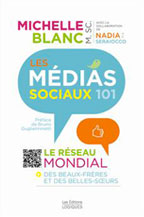La pourriture marketing web Partie 2 (fraude par clic)
Ce billet est la suite du précédent billet La pourriture marketing web Partie 1
Votre site est l’étoile de votre système solaire
C’est le pote Jacques Warren qui sur LinkedIn, à la suite de mon partage de l’article The Role Of A Website Today me fit parvenir la baladodiffusion Ad Fraud with Dr. Augustine Fou du site Analyticshour. Dans l’article de Forbes, l’auteur écrivait ce que Jacques et moi-même disons depuis une vingtaine d’années. La présence web la plus importante de toutes stratégies numériques est votre propre site Web. Toutes vos autres présences sociales et activités de marketing numérique ne devraient avoir qu’un seul objectif, celui de faire cheminer un internaute vers VOTRE propriété internet et le pousser vers la conversion, c’est-à-dire de le faire acheter, demander une soumission, vous contacter ou remplir un questionnaire.
Don’t simply hire the local hipster you met at the coffee shop to create your business website. You wouldn’t do that to fix your car, so why would you do that with something so important to your business? Make sure your website developer has SEO, marketing, lead generation and programming knowledge because your competitors likely will.
Your website is the mother ship; it’s where all the important information is exchanged and where the most important digital actions take place. It’s not something to be taken lightly, and it’s not something to skimp on.
Mais l’auteur conseille aussi de travailler avec des gens qui savent ce qu’ils font et ne sont pas le “hipster local” ou le beau-frère qui prétend connaître le domaine parce que très possiblement vos compétiteurs eux, engageront des ressources compétentes.
La fraude par clic
(vous pouvez lire mes billets de 2006 sur le sujet
Fraudes par clic, Yahoo condamné à son tour, Google et Yahoo se font ramasser pour les fraudes par clic)
Pour revenir à la baladodiffusion citée plus haut, il s’agit en fait d’une entrevue avec le Dr Augustine Fou. Titulaire d’un PhD de MIT et professeur de marketing à Rutgers University and NYU, en plus d’avoir été consultant pour certaine des plus importantes entreprises de consultation de la planète, qui s’est intéressé et a décortiqué en profondeur le très vieux problème de la fraude par clic. À mes débuts, il y a de nombreuses années, on parlait déjà de 20% des budgets de publicité numériques qui étaient en fait de la fraude. Puis on parla plus récemment de 30 puis de 50%. La blague étant même “que 50% des budgets de placement de publicité numériques sont de la fraude, mais on ne sait pas lequel des deux 50% est le bon”. C’est tout dire. Mais avec l’avènement de la programmatique, selon le Dr. Fou, ce pourcentage de dépenses frauduleuses monterait maintenant à 90%, dans certains cas. C’est difficile à croire et ce sera sans doute un choc pour plusieurs lecteurs, mais ses explications sont des plus réalistes et documentées. La pub numérique serait donc une machine à imprimer de l’argent frauduleusement.
Pour vous en convaincre, voici des extraits de cette discussion de plus d’une heure et que vous pouvez écouter intégralement ici https://www.analyticshour.io/2019/09/10/123-ad-fraud-with-dr-augustine-fou/
(…)
And with the rise of programmatic, we started seeing things like 30% click-through rates, 50% click-through rates, 0% bounce rates, and things like that. And so all of those were strange. Those don’t make sense because humans are just not that interested in your damn ad.(…)
And over the years, there’s some young marketers coming out that don’t have the experience to know that click-through rates on banner ads were supposed to be in the 0.1% range, and search ads in the 1% range. When you see 30% click-through rates, something’s wrong with that. So they don’t have that common sense that something is strange ’cause that’s been the norm that they’ve been seeing.(…)at just doesn’t do anything to damage my assumption that agents, that media agencies are not incentivized to actually ferret out ad fraud.
(…)So think of the ad exchanges. They make more money when there’s more volume that passes through their exchange. So anything like ad fraud, if we discover that 50% of the volume is fraudulent, they would be making a lot less money. So some are simply looking the other way because they’ll say, “It’s not our job to look for that. It’s your job as a marketer. If you wanna waste the money, it’s your problem.”
(…) Literally, they are glued they might as well have a third arm holding the phone in front of their faces, 6 inches away from their face for 24 hours a day, including when they sleep. And that even that can’t account for all of the trillions upon trillions of ad impressions that were purportedly trading in digital marketing these days.
(…)And the one thing I think that a lot of people in the group that didn’t work in data and marketing, couldn’t understand, was how do the fraudsters actually get money out of it?
(…)
Think of a whole bunch of computers, compromised with malware, or laptops or now, smartphones. There’s 10 times more smartphones than there are computers. And furthermore, the smartphones are left on 24/7, as opposed to computers or laptops, which you turn off at night.
0:16:17 DF: So when you have all these smartphones that can be remotely controlled by a bot master, you can now have millions and millions of devices that do certain things. So you could say, go hit this one website with so much traffic that it can’t come up anymore or you can point that traffic firehose to a site that has ad tech on it. So when there’s ad tech on it, it will start showing ads every time you load the webpage. And so, that’s how the early bots started to make money, by generating ad fraud. All they had to do was cause the page to load and then all these ads would load. And think about sticking five ads on the page or 10 ads on the page. Or if you’re really unscrupulous, 1500 ads on the page. So on and so forth, right?(…)
But kind of tying this back to the ad fraud, those sites have no traffic. So, they would just go out and buy all their traffic. And it’s a very simple arbitrage, right? If you buy your traffic for $1 and you sell your ads for $2, you’ve just made 100% profit. Pure profit. And there’s many, many variations. Sometimes you buy the traffic for a dollar, you can sell your ads for $10. Now you’ve made a 9 X markup. So some of my studies in that 2018, q2 ad fraud deck, you can see 25 X return. 42 X return. That’s not 42%, that’s 4200% return, for every dollar you spend in digital ad fraud. So why wouldn’t you spend the next dollar, to then make $42?(…)Oh, yeah. Well, I’m in charge of $30 million of spending in digital.” So they will have to spend it all. If they don’t spend it all, they risk losing some of it, right? They won’t have as much to spend next year, so they will find every means to spend it and also find the means to make sure everything looks right. So they will buy those fraud detection reports that specifically say, “There’s no fraud, don’t worry about it.” Alright, so that provides them air cover, so that they can continue buying that. Even if some boy scout showed them the data that, “This is all fraudulent, you know that, right?” They’ll say, “Don’t tell anyone. We wanna keep buying.”
(…)
Ad front is not a tech problem, it’s an incentives problem, and that goes all the way up to the marketer themselves, the parties that are spending them, the dollars.(…)
And there was a recent study I tweeted within the last week or so that there’s another larger study that showed, and this was interview, so I wouldn’t put too much weight on it, but marketers, like more than half of them, said digital marketing, especially programmatic display and all that kind of stuff, didn’t generate any noticeable business outcomes, and that was being kind. It was a complete waste of money, but they put it in the sense that it didn’t generate any noticeable business outcomes. Of course, you didn’t notice anything, because it didn’t do anything.(…)
It’s a game of finding out which clients actually care to hear what we have to say.
J’ai toujours refusé de faire de la pub numérique pour mes clients. Depuis le temps, je sais qu’une portion très importante de leur argent servira à faire vivre un système plutôt que de générer de la conversion. Je préfère de loin la pérennité de peurs investissements via le marketing de contenu. C’est plus de job et moins de fric pour les agences, c’est donc moins sexy et pas mal moins payant pour moi. Mais le soir, lorsque je me couche, je dors beaucoup mieux…
Épilogue
La crise des médias n’est pas que le fruit d’une incompétence de certains éditeurs à s’adapter. Elle est aussi la résultante des décideurs marketing à investir dans des pubs internet qui ne vendent que du vent…
Vous pourriez aimer lire
Legal Cases Documenting Details of Fraud
What The Hell Happened to Good Publishers 1995 2015
State of Digital Ad Fraud Q2 2018
6 Months After Fraud Cleanup, AppNexus Describes Impact On Its Exchange
Calling Bullshit, Data Reasoning in a Digital World
Article publié le vendredi, 4 octobre 2019 sous les rubriques Commerce électronique: mythes, hacking, Marketing Internet, marketing mobile et Medias et Internet.












